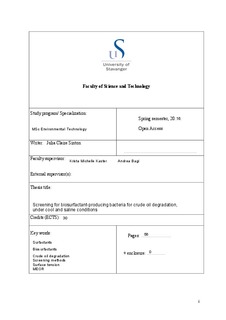| dc.contributor.advisor | Kaster, Krista | |
| dc.contributor.advisor | Bagi, Andrea | |
| dc.contributor.author | Sinton, Julia Claire | |
| dc.coverage.spatial | Norway | nb_NO |
| dc.date.accessioned | 2016-09-26T14:14:58Z | |
| dc.date.available | 2016-09-26T14:14:58Z | |
| dc.date.issued | 2016-06 | |
| dc.identifier.uri | http://hdl.handle.net/11250/2410789 | |
| dc.description | Master's thesis in Environmental technology | nb_NO |
| dc.description.abstract | Using three sources with different hydrocarbon exposure histories—bacteria grown from
Arctic seawater (Arctic), and bacteria from an offshore wastewater treatment system from
both the bioreactor (BR) and settling chamber (SC)—biosurfactant production capabilities for
crude oil degradation were tested. Isolation for colony purity for later DNA sequencing was
also attempted, but was not successful. Traditional techniques, for both cultivating bacteria
and biosurfactant production assessment methods were applied.
The majority of Arctic samples demonstrated positive results for the qualitative tests—oil
drop collapse and visual emulsion and flocculation test—for biosurfactant screening. Only 15
of the 34 samples showed a reduction of 10-37% of the measured surface tension of seawater
liquid media with oil. The presence of the oil (Tyrihans) alone lowered surface tension to of
the media to 58.114 mN/m from 73.115 mN/m of seawater media without oil.
All SC and BR samples cultivated with nutrient agar and broths failed to demonstrate
significant changes in surface tension. The greatest recorded change was with BR sample 6,
which reduced surface tension of the control with oil from 38.843 mN/m to 36.667 mN/m.
The 5 BR cultures from Bushnell Haas (BH) media with oil produced strong emulsions,
which were difficult to break, as well as demonstrating complete spreading in the oil drop
collapse test. The lowest recorded surface tension produced by sample 2 was 32.829 mN/m,
compared to the control liquid BH media with oil of 54.003 mN/m. SC samples provided
more possible candidates for biosurfactant production, with 8 samples reducing the surface
tension to between 24.245 mN/m and 27.556 mN/m. Based on the results, SC bacteria have a
greater potential as candidates for future analysis of biosurfactant production, and the BH
media is better suited for cultivation purposes than the nutrient agar and broth media. | nb_NO |
| dc.language.iso | eng | nb_NO |
| dc.publisher | University of Stavanger, Norway | nb_NO |
| dc.relation.ispartofseries | Masteroppgave/UIS-TN-IMN/2016; | |
| dc.rights | Navngivelse 3.0 Norge | * |
| dc.rights.uri | http://creativecommons.org/licenses/by/3.0/no/ | * |
| dc.subject | MEOR | nb_NO |
| dc.subject | teknisk miljøvern | nb_NO |
| dc.subject | surfactants | nb_NO |
| dc.subject | biosurfactants | nb_NO |
| dc.subject | crude oil degradation | nb_NO |
| dc.subject | screening methods | nb_NO |
| dc.subject | surface tension | nb_NO |
| dc.subject | environmental technology | nb_NO |
| dc.title | Screening for biosurfactant-producing bacteria for crude oil degradation, under cool and saline conditions | nb_NO |
| dc.type | Master thesis | nb_NO |
| dc.subject.nsi | VDP::Technology: 500::Environmental engineering: 610 | nb_NO |
| dc.source.pagenumber | 56 | nb_NO |

